
The Louisiana Purchase Exposition, informally known as the St. Louis World's Fair, was an international exposition held in St. Louis, Missouri, United States, from April 30 to December 1, 1904. Local, state, and federal funds totaling $15 million were used to finance the event. More than 60 countries and 43 of the then-45 American states maintained exhibition spaces at the fair, which was attended by nearly 19.7 million people.

Ralph Adams Cram was a prolific and influential American architect of collegiate and ecclesiastical buildings, often in the Gothic Revival style. Cram & Ferguson and Cram, Goodhue & Ferguson are partnerships in which he worked. Cram was a fellow of the American Institute of Architects.

Bellefontaine Cemetery is a nonprofit, non-denominational cemetery and arboretum in St. Louis, Missouri. Founded in 1849 as a rural cemetery, Bellefontaine has several architecturally significant monuments and mausoleums such as the Louis Sullivan-designed Wainwright Tomb, which is listed on the National Register of Historic Places.
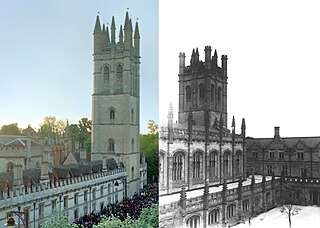
Collegiate Gothic is an architectural style subgenre of Gothic Revival architecture, popular in the late-19th and early-20th centuries for college and high school buildings in the United States and Canada, and to a certain extent Europe. A form of historicist architecture, it took its inspiration from English Tudor and Gothic buildings. It has returned in the 21st century in the form of prominent new buildings at schools and universities including Cornell, Princeton, Vanderbilt, Washington University, and Yale.
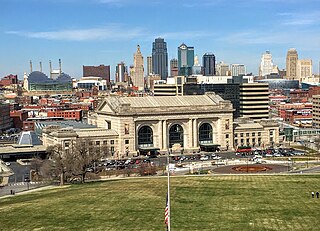
Downtown Kansas City is the central business district (CBD) of Kansas City, Missouri and the Kansas City metropolitan area which contains 3.8% of the area's employment. It is between the Missouri River in the north, to 31st Street in the south; and from the Kansas–Missouri state line eastward to Bruce R. Watkins Drive as defined by the Downtown Council of Kansas City; the 2010 Greater Downtown Area Plan formulated by the City of Kansas City defines the Greater Downtown Area to be the city limits of North Kansas City and Missouri to the north, the Kansas–Missouri state line to the west, 31st Street to the south and Woodland Avenue to the east. However, the definition used by the Downtown Council is the most commonly accepted.

Quality Hill is a historic neighborhood near downtown Kansas City, Missouri, USA, on a 200-foot-high bluff which overlooks the confluence of the Kansas and Missouri rivers in the West Bottoms below.

The Sisters of Loretto or the Loretto Community is a Catholic religious institute that strives "to bring the healing Spirit of God into our world." Founded in the United States in 1812 and based in the rural community of Nerinx, Kentucky, the organization has communities in 16 US states and in Bolivia, Chile, China, Ghana, Pakistan, and Peru.

Theodore C. Link, FAIA, was a German-born American architect and newspaper publisher. He designed buildings for the 1904 World's Fair, Louisiana State University, and the Mississippi State Capitol.
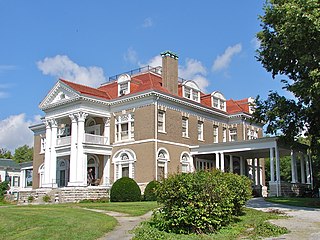
Rockcliffe Mansion is located in Hannibal, Missouri (USA) and was built in 1898 by John J. Cruikshank, Jr, a descendant of Scottish immigrants, whose fortune was founded on lumber. He erected the residence on West Bird Street. It came to be acknowledged as the most imposing, beautiful and costly residential structure in that part of the state of Missouri. "By reason of its location on a high, rocky eminence, overlooking the entire city [and the Mississippi River], it [was] termed 'Rock Cliff' [later known as "Rockcliffe"], and is one of the many attractions of the city invariably viewed by strangers and tourists visiting Hannibal." It is located in the Maple Avenue Historic District.

Mary Rockwell Hook was an American architect and a pioneer for women in architecture. She worked principally from Kansas City, Missouri but designed throughout the United States. She was denied admission to the American Institute of Architects (AIA) due to her gender.

Eames and Young was an American architecture firm based in St. Louis, Missouri, active nationally, and responsible for several buildings on the National Register of Historic Places.

Barnett, Haynes & Barnett was a prominent architectural firm based in St. Louis, Missouri. Their credits include many familiar St. Louis landmarks, especially a number related to the local Catholic church. Their best-known building is probably the Cathedral Basilica of St. Louis. A number of the firm's works are listed on the U.S. National Register of Historic Places.

Thomas P. Barnett, also known professionally as Tom Barnett and Tom P. Barnett, was an American architect and painter from St. Louis, Missouri. Barnett was nationally recognized for both his work in architecture and in painting.

Holy Name of Mary Proto-Cathedral, also known as St. Mary Proto-Cathedral, is a historic Roman Catholic parish church in Sault Ste. Marie, Michigan, United States, that was formerly a cathedral church and the first cathedral, hence "proto-cathedral", of the Roman Catholic Diocese of Marquette. It is the oldest parish and oldest cathedral parish in Michigan, and the third oldest parish in the United States. While the present church edifice, the fifth for the parish, dates from 1881, the parish began in 1668 as a Jesuit mission. It was listed on the National Register of Historic Places in 1984 and designated a State of Michigan historic site in 1989. The proto-cathedral was the (first) cathedral of the Diocese of Marquette when it was denominated the "Diocese of Sault Sainte Marie", which diocesan title is presently that of a titular episcopal see.
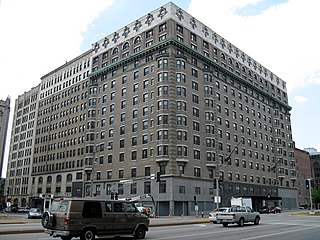
The Jefferson Arms is a historic building in downtown St. Louis, Missouri. It opened as the Hotel Jefferson in 1904 to serve visitors to the Louisiana Purchase Exposition and was named in honor of Thomas Jefferson.

Immaculate Conception Church and Rectory is a former Catholic church and adjacent rectory in St. Louis, Missouri, United States. It is the home of the Compton Heights Concert Band. The former church and rectory are listed on the National Register of Historic Places.

Frank M. Howe was an architect in Kansas City, Missouri, and Boston, Massachusetts. He was a partner with Henry Van Brunt in the prominent firm of Van Brunt and Howe. He later partnered with Henry F. Hoit as Howe, Hoit & Cutler.
The Danforth Chapel Program was funded by the Danforth Foundation, an organization created in 1927 by William H. Danforth, founder of the Ralston Purina Company, and his wife. The Danforth Foundation focused on national education philanthropy: providing scholarships to college students, supporting projects to revitalize the city of St. Louis, and funding the Danforth Chapels. The Danforth Foundation closed in 2011 with a gift of $70M to the Donald Danforth Plant Center, a research center that focuses on solving world hunger.
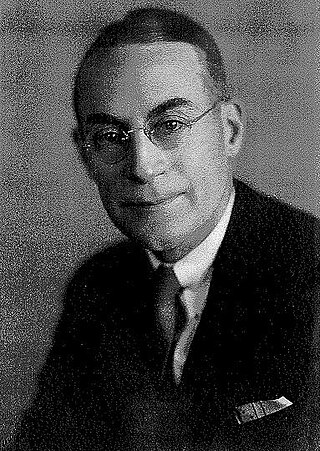
Robert James Raney was an American architect who worked for 20 years as the chief architect of the Fred Harvey Company system. He is notable for the work he did for Fred Harvey during those years, as well as numerous other projects before and afterward.

The Waterman Place-Kingsbury Place-Washington Terrace Historic District in St. Louis, Missouri is a historic district which was listed on the National Register of Historic Places in 2007. The listing included 223 contributing buildings, four contributing structures, and a contributing site on 66.7 acres (27.0 ha). It also includes 15 non-contributing buildings and three non-contributing structures.






















